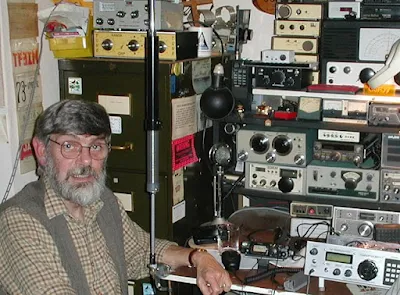 On my little Colpitts/DaVinci/G0UPL less-than-10 mW QRSS rig, I started out with a forward biased (downward pointing) Superbright Blue LED (from AL7RV). (Refer to Hans' schematic, above.) You can see the resulting pattern below. That is my signal above that of Alan, VK2ZAY. At first I thought the diode was just switching in the 5 pf cap, but Hans (who knows this turf far better than I) thinks it is more of a varactor action. I now think it is a little of both: When that + 2.5 volts from the multivibrator hits the diode, it goes partially on (it even glows a bit). This puts the 5 pf cap into the circuit (through the resistance of the diode). The diode itself increases in capacitance because of the increased forward bias. As a result, the total capacitance increases, and the frequency drops a bit. Thus, forward-biased diodes result in upside down FSK. You can see a bit of the varactor action in the curve on the trailing edge of my not-so square waves -- I think that marks the period in which the voltage from the multivibrator is slowly rising:
On my little Colpitts/DaVinci/G0UPL less-than-10 mW QRSS rig, I started out with a forward biased (downward pointing) Superbright Blue LED (from AL7RV). (Refer to Hans' schematic, above.) You can see the resulting pattern below. That is my signal above that of Alan, VK2ZAY. At first I thought the diode was just switching in the 5 pf cap, but Hans (who knows this turf far better than I) thinks it is more of a varactor action. I now think it is a little of both: When that + 2.5 volts from the multivibrator hits the diode, it goes partially on (it even glows a bit). This puts the 5 pf cap into the circuit (through the resistance of the diode). The diode itself increases in capacitance because of the increased forward bias. As a result, the total capacitance increases, and the frequency drops a bit. Thus, forward-biased diodes result in upside down FSK. You can see a bit of the varactor action in the curve on the trailing edge of my not-so square waves -- I think that marks the period in which the voltage from the multivibrator is slowly rising:
Just to make Hans happy, I switched from a forward biased blue to a reverse biased (upward pointing) red diode. The resulting pattern (below) looks a lot like the pattern shown in the picture in Hans' excellent SPRAT article. This is clearly FSK. The positive voltage from the multivibrator increases revers bias on the LED, DECREASING capacitance and RAISING the oscillator frequency. In the curve of the leading endge of the pattern you can see the voltage from the multivibrator slowly rising. FSK here is "right side up."

Finally I tired a little 1N914 diode forward biased. I was hoping to see some cleaner switching action, but even with this little diode you can see quite a bit of varactor action at work:

I think the switiching would be a lot cleaner and more complete if the voltage from the multivibrator wasn't coming through a 1 meg resistor. But when you put a lower resistance in place of the 1 meg ohm part, you start to mess up the frequency of the multivibrator.
I have to say, my favorite pattern is that from the Blue diode forward biased. Sorry Hans. To each his own...












